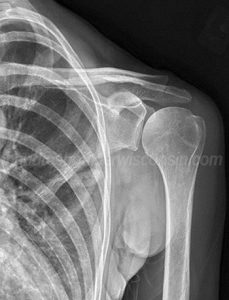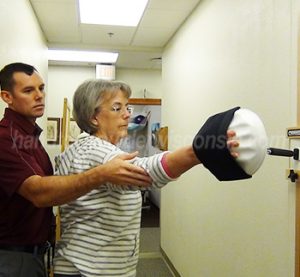At Hand to Shoulder Center of Wisconsin in Appleton and Green Bay, our orthopedic staff understands shoulder replacements and how important the right form of care before, during, and after shoulder surgery can be for our patients. Contact the orthopedic team at Hand to Shoulder Center of Wisconsin to see how we can help you.
Shoulder Replacement

Figure 1: Ball and socket design
The shoulder is made up of three bones: the scapula (shoulder blade), the humerus (upper arm bone), and the clavicle (collarbone); all are surrounded and stabilized by a number of muscles, ligaments, and tendons. It is the most mobile joint in the body due to its ball and socket design (Fig. 1). The ball or head of the humerus fits into the shallow socket of the scapula which allows the shoulder full range of motion. The head of the humerus and socket of the scapula are both covered with a generous amount of cartilage. This provides a cushion for the 2 bones to move on each other. When significant arthritis is present, a shoulder replacement surgery may be a viable procedure to be considered.
Shoulder replacement, often referred to as total shoulder replacement, is surgery that replaces the damaged joint of the shoulder with artificial components. This procedure was originally designed to treat severe shoulder fractures however it has evolved over the years and is now used to treat many causes of shoulder pain such as severe shoulder arthritis.
In shoulder replacement surgery, treatment options vary depending on the condition of the shoulder joint. Typically, the head of the humerus is replaced with a highly polished metal ball attached to a stem. The stem is inserted down the shaft of the humerus and is often cemented or “press fit” into the bone. Depending on the condition of the socket and the rotator cuff tendons, the socket may also warrant replacement. This is done by cementing a plastic piece that fits into the groove of the original shoulder socket.
Causes
Shoulder pain symptoms can develop over time from day to day wear-and-tear activities. Patients with significant fractures or advanced arthritis in the shoulder may be good candidate for shoulder replacement surgery.
When non-surgical treatments such as medications and/or activity changes no longer are helpful for shoulder pain relief, consideration of shoulder joint replacement surgery may be a safe and viable solution.
Evaluation and Treatment
The physicians at Hand to Shoulder Center of Wisconsin are fellowship-trained orthopedic surgeons with additional knowledge and experience in the upper extremity (fingertip to shoulder). A thorough medical evaluation is performed, medical history along with past and present shoulder injuries and shoulder pain treatment options are discussed, and all prior shoulder surgery procedures are reviewed.
During the evaluation, stability and strength along with active and passive range of motion is measured visually and physically on the affected shoulder and the opposite shoulder. X-rays are taken to view the condition of the shoulder joint. X-rays will show a fracture, loss of the normal joint space between the bones, and any abnormality in the shape or function of the joint. Additional tests, such as a Magnetic Resonance Imaging (MRI) or CT scan, may be ordered to further detect additional damage to the shoulder and surrounding soft tissue.
Surgery
Total shoulder replacement surgery is highly technical. It is an inpatient surgery that usually requires a one to three day stay in the hospital. The surgery itself typically takes two to three hours to be completed.
An incision is made across the front of the shoulder to provide easy access to the affected joint. Due to the nature of the surgery, arthroscopic shoulder surgery is not an option for shoulder joint replacement surgery. Once the shoulder surgery is completed, you are taken to the recovery room where you will be monitored by the anesthesiologist.
During your brief stay at the hospital, physical or occupational therapy exercises will begin. These exercises will help to prevent the shoulder muscles from getting stiff.
Rehabilitation
Rehabilitation is a vital part of the shoulder replacement recovery process. During the recovery time, the patient will work directly with a licensed physical or occupational therapist in developing a rehabilitation program that will focus on pain relief, restoring range of motion, and overall function. A physical or occupational therapist will work with you on a hands-on treatment plan (Fig. 2-3) to maximize your recovery time and improve your overall outcome. A graduated process that follows tissue healing time is monitored by the physician and therapist. By 6-8 weeks, gentle active use of the affected arm may be resumed with limited functions – no heavy lifting, pulling, or pushing will be allowed. At the end of 3-4 months, patients typically are resuming full use of the extremity provided they have achieved sufficient range of motion.
 Figure 2: Shoulder strengthening exercises |
 Figure 3: Shoulder strengthening exercises |
The highly trained physicians and therapists at Hand to Shoulder Center of Wisconsin are among the most skilled in diagnosis and treatment of shoulder conditions. Shoulder replacement surgery is performed at three surgery locations in Appleton and Neenah, WI.
